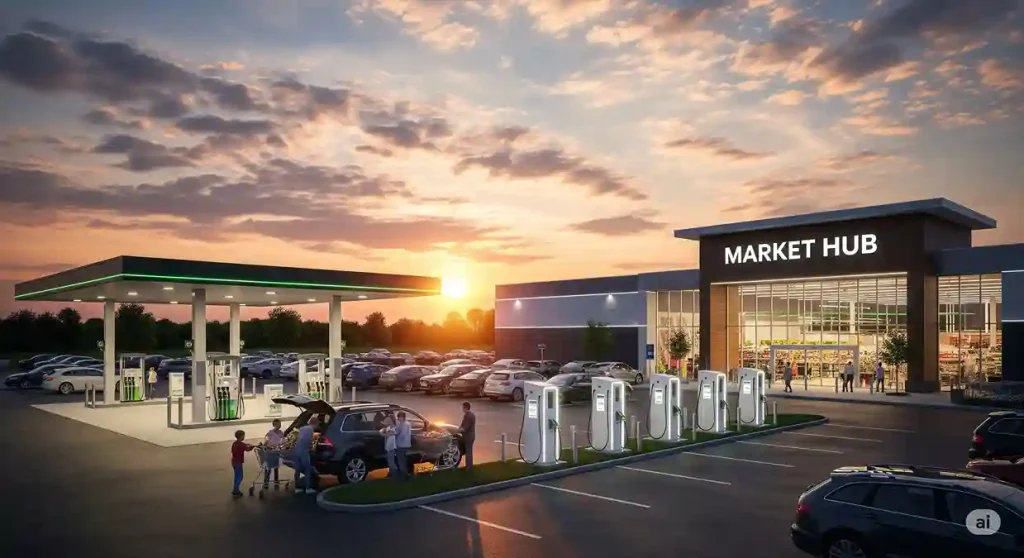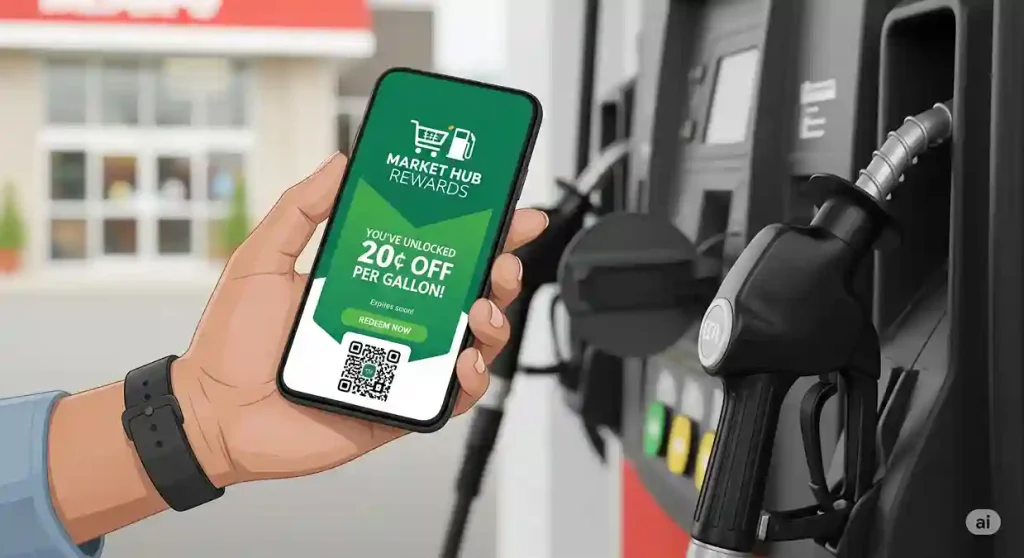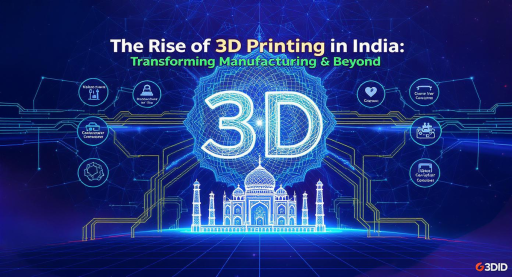In recent years, you may have noticed a trend: The same stores where you shop for groceries, clothing, and electronics now invite you to fill your car’s gas tank. Fuel forecourts are being added to the locations of major retailers from supermarkets to warehouse clubs. This is transforming parking lots into energy hubs. This is not an expansion that was made at random; this is a powerful and calculated business strategy which is changing the retail and fuel industry.
This article will examine the reasons behind this global trend. We will explore the strategic reasons that make high-volume retailers so interested in selling gasoline, a product with a low margin. Learn about their different entry models and how they future-proof these investments. This shift creates a new and convenient shopping experience for both businesses and customers.

Unpacking the strategic motives
On first glance, it may seem odd that a large-box or supermarket would sell gasoline. Fuel is notoriously low-profit. Retailers aren’t just selling fuel. They are also using it to boost their core business.
Setting Up Production Business Of Transparent Fiberglass LPG Cylinders
The Ultimate Traffic Driver
Fuel is an extremely valuable commodity. Fuel is an essential, frequent purchase by a large majority of households. Customers are very sensitive to the price. Gasoline at a competitive price is a great incentive to customers. Few cents per gallon are enough to convince a customer to drive past other gas stations in order to reach their forecourt. This makes the retail store a destination and not just an option. It increases the number of people who visit the main store. The constant stream of customers, or traffic is vital to any retail business.
Supercharging customer loyalty
Fuel sales are integrated into existing loyalty programs by retailers as one of their most effective strategies. Now you can earn points for your groceries, which translate to significant discounts on the gas pump or vice versa. A supermarket may offer a 10-cent per gallon discount for every $100 spent in-store. This creates an incredibly powerful and self-reinforcing loyalty cycle. Fuel savings increase as a result of the number of purchases made by a customer. Fuel is a major factor in the decision to shop at the store. This turns a simple card into an essential tool for saving money in the household, making it harder for competitors to entice that customer away.
The Ultimate One-Stop Shop
Convenience is the key to modern life. Fuel stations allow retailers to tap into this demand by offering a one-stop shop experience. The customer can complete three major tasks in one trip: filling up their car, shopping for groceries and household items. It saves customers time and money, giving them a huge competitive advantage. The retailer becomes an essential part of the customer’s daily routine because they can do all their errands at once.
Increase In-Store Sales and Basket Value
Fuel purchases are closely linked to in-store purchases. The barrier for a customer to enter the store when they are already in the gas station is almost nonexistent. Fuel stations are strategically placed to encourage this type of behavior. This encourages impulse purchases and higher overall sales. Customers who come in just to buy fuel may decide to grab a snack or drink while they’re there, or do all their weekly shopping. The result is a higher “basket-size”, which is the total amount spent by a customer per visit. This directly increases the retailer’s revenue and profits.
Read Our Book: Click Here
The Blueprint to Enter the Fuel Market
It is a big undertaking to enter the highly regulated, logistically complex and heavily regulated fuel business. Retailers usually follow a few models that have been proven to be successful.
The Hypermarket Forecourt Model
Costco, Kroger and Walmart are all large retailers that use this approach. The company purchases the land (often an underutilized portion of their parking lot) and builds its own fuel station. The company manages the entire operation from construction to regulatory compliance, supply chain logistics, and daily operations. They have complete control of pricing, branding and integration with loyalty programs. This model requires a large capital investment, but has the best potential for brand reinforcement and long-term returns.
Leveraging Strategic Partnerships
Some retailers enter the market through a partnership with an established energy and fuel company. This model allows the energy company to own and run the fuel forecourt, while the retailer manages the convenience store. In India, a prime example of this is the partnership between Reliance & bp who operate under the JIO-bp label. The partnership allows each company the opportunity to concentrate on their core strengths. This allows the energy giant to handle the complicated fuel regulations and logistics, while the retailer can apply its expertise in merchandising and supply chain as well as customer experience at the c store, creating the best of both worlds.
Read Our Project Report: Click Here
Designing to Efficiency and Profit
Modern retail fuel stations have been designed to maximize efficiency and volume. They have a lot more pumps and wider lanes than traditional gas stations. This allows them to serve more vehicles, while reducing wait times. The payment process is simplified by “pay at the pump” technology, and mobile apps.
Retailers also recognize that convenience stores are a significant profit center. The c-stores are bright, clean and well-stocked, offering much more than chips and soda. You’ll find fresh-made sandwiches and healthy snacks as well as high-quality coffee. These high-margin products help offset the low fuel margins and are an important part of the overall profitability of the business.

The Future Retail Fuel Market: EVs and Tech, and Improved Service
Retailers do not only think about the present, they also prepare for the future.
The Electric Vehicle Revolution
In order to prepare for the future, fuel stations are installing charging stations. It is important to stay relevant. A driver of an EV might charge their car for 20-30 minutes, which is far longer than the few seconds it takes to fill up with gas. This longer dwell time is a great opportunity to get the customer to come into the store for shopping or eating. Retailers can cater to the needs of all drivers by offering both traditional fuel pumps as well as EV chargers.
Integrating technology for a seamless experience
Modern retail fuel is a technology-driven experience. Apps for mobile devices are increasingly important. Apps can be used to track loyalty points, pay for gas, activate the pumps, order items at the c-store, or even place orders for curbside pickup. These data allow retailers to send you personalized offers and discounts straight to your phone. This will increase loyalty and encourage repeat business.
Discover the Right Business for You With Our Startup Selector Tool
Conclusion
Major retailers’ entry into the fuel industry is a strategic move that goes far beyond selling gasoline. Fuel at competitive prices is used as a magnet to attract customers to their properties. Once there, they use loyalty programs and convenience to grab a bigger share of household budgets. The “one-stop shop” model has changed consumer behavior by allowing them to fill up their tank and stock up on groceries in one trip.
These retail hubs are evolving to become the one-stop-shops for modern consumers. They integrate EV charging stations, mobile technology and enhanced convenience store offerings. No longer are you just visiting a shop or gas station. You are now interacting with an integrated ecosystem that will save you money and time. This trend is only going to increase in the coming years.
Retailers Entering Fuel Business: Frequently Answered Questions (FAQs)
Q1: Does selling fuel to supermarkets and other retailers make sense?
Yeah, it actually does. The profit per gallon is tiny, but it gets people at the pump—then they often wander in and buy snacks or stuff with bigger markups. So, gas pulls ‘em in; the store cashes in.
Q2: What are the most common retail fuel rewards programs?
Usually, it’s “spend more, save more on gas.” Buy a bunch of groceries, and you get a few cents off per gallon. Just scan your loyalty card or punch your number at the pump. Easy.
Q3: Do I need to be a member to buy gas at a warehouse club like Costco?
Pretty much, yeah. Costco and Sam’s Club make you scan your membership before you can fuel up. No membership, no gas.
Q4: Do retailers who sell gasoline also prepare for electric cars?
Absolutely. The smart stores are adding fast EV chargers. Charging takes longer, so people hang around and spend more inside. Win-win for them.
Q5: What are the main challenges facing a retailer who wants to enter the fuel industry?
Honestly, it’s a hassle. You deal with tons of rules, safety stuff, and wild price swings. It’s way more complicated than just adding pumps.






